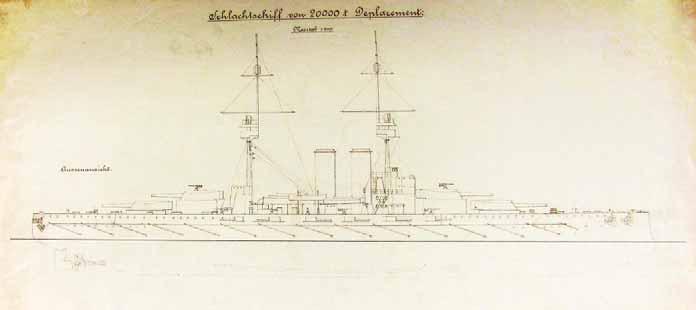The Final Design After the successful underwater explosion test, MTK worked on improving their design. Ironically, on the same day as the assassination of Franz Ferdinand and his consort in Sarajevo, the MTK presented to the Navy their final version of the design of the 24,500 ton or “Improved Tegetthoff ” class battleship. The design was approved by the Navy on 1 July.384 The “Improved Tegetthoff ” class represented a more balanced design than the Tegetthoff class. This design was not overloaded by the main armament therefore it was more stable thanks to the lower center of gravity. The raised forecastle helped to improve her expected seagoing performance. Furthermore, the crew compartments were more spacious in these ships compared to the earlier battleships. The survivability of the 24,500 ton design was largely improved compared to the first dreadnought class due to the improved torpedo protection system, the better compartmentalization of the hull under the armored deck and the thicker armor. The displacement of the “Improved Tegetthoff ” class was by 4,500 tons or 22.5 percent larger than the displacement of the Tegetthoff class. The greater part of the increase was dedicated to protection and survivability. The weight of the vertical armor was 1,300 tons or 26 percent greater, the thickness of the belt armor was increased by 10 percent (from 280 to 310 mm) while the thickness of the casemate armor was decreased by 17 percent (from 180 to 150 mm). The weight of the hull (including watertight bulkheads) rose from 5,313 tons to 7,094 tons (33 percent), which indicates the intention of
the designers to create a much stronger hull structure. The weight of the main battery including gun turrets rose only slightly, from 2,798 tons to 2,914 tons, while the weight of a broadside rose from 5,400 kg to 6,350 kg. The design speed of the new battleships was 21 knots or 1 knot more than that of the preceding two classes. The specific (per ton) price of the new battleships also rose by 12 percent from 3,000 to 3,360 Kronen Seven years after the preceding decision, in 1911 the Navy decided again for introducing a new caliber. In the summer of 1912, it was decided that the main armament of the new battleships would consist of ten 35 cm/45 guns mounted on two triple and two twin turrets. The 635 kg projectile of this gun was 41 percent heavier than the 450 kg projectile of the 30.5 cm/45 gun. There are no actual test results available, only theoretical calculations, on the basis of which we can suppose that the armor penetration capability of the 35 cm APC would have exceeded by approximately 15 percent that of the 30.5 cm APC. The Navy also decided for the first time in its history to introduce for this gun a light APC projectile (Einheitsgranate), which armor penetration capability would have been theoretically equal to that of the 30.5 cm APC. The large ammunition hoists of the 35 cm turrets (length of the hoist car was 1,500 mm) could handle projectiles fitted with 5.25 crh ballistic cap. In June 1912, the Navy abandoned pursuing the idea of any-angle loading. This decision made possible reducing the barbette diameter of the 35 cm triple turret from 11.2 m to 10.3 m. The barbette diameter of the twin turrets was still 560 mm (8500 mm) greater than that of the British 34.3 cm
51 The final design of the “Improved Tegetthoff ” class battleships from June 1914 without the upper casemate around the conning tower
— 112 —






























